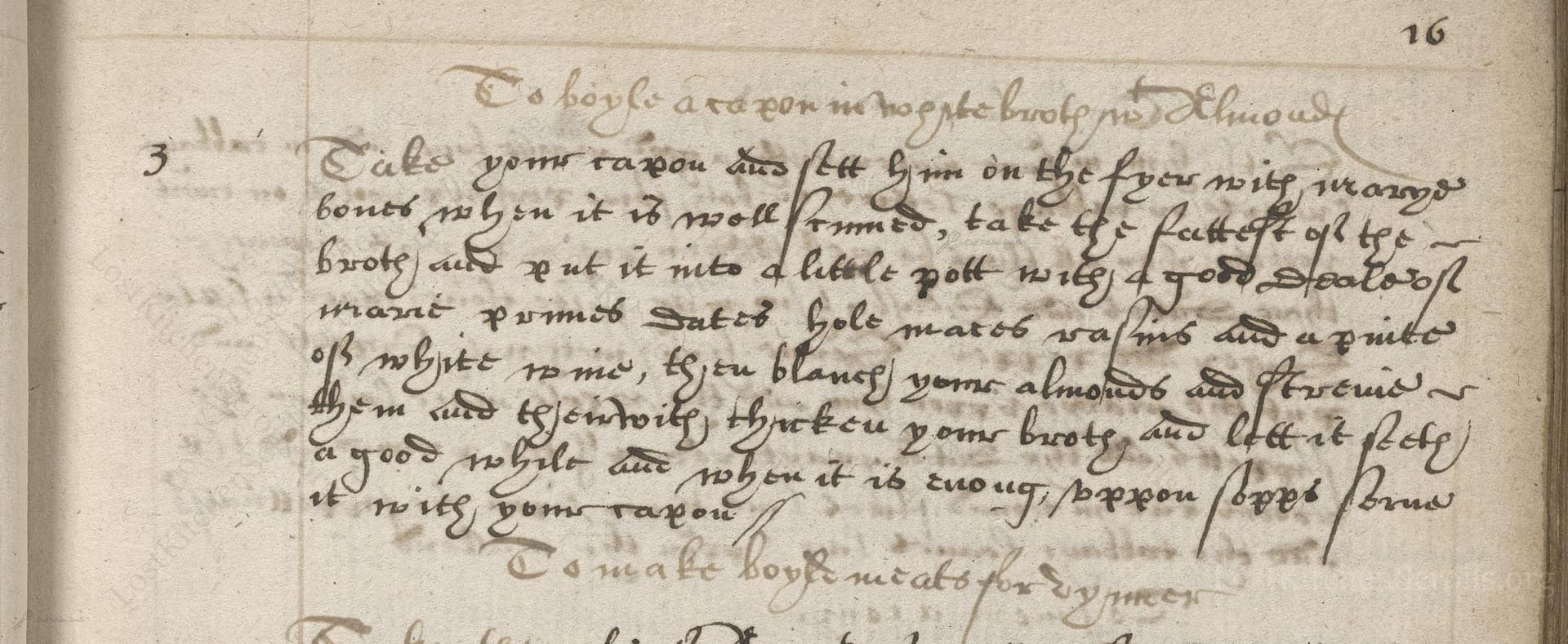To Boyle A Capon In Whyte Broth Or Almond Mylk
From the treasured pages of Certain profitable and well experienced collections for making conserve of fruits
Written by Nicholas Webster

To Boyle A Capon In Whyte Broth Or Almond Mylk
"Take your capon and breake him on the fowre with marrow bones, put it in a little pott with a good quantitie of white wine, take a good handfull of your almonds and streine them with your broth, and lett it seeth till it is enough, season it with suger, pepper, cloves & mace."
Note on the Original Text
The recipe is written in the direct, practical style of 17th-century English household manuscripts, with almost no measurements and a reliance on the cook's understanding and intuition. Spelling reflects early modern conventions (e.g., 'boyle' for 'boil', 'whyte' for 'white', 'seeth' for 'simmer' or 'cook'), and instructions are brisk, assuming the reader's familiarity with handling poultry and spices.

Title
Certain profitable and well experienced collections for making conserve of fruits (1650)
You can also click the book image above to peruse the original tome
Writer
Nicholas Webster
Era
1650
Publisher
Unknown
Background
Step back to the bustling kitchens of mid-17th century England with this flavorful collection by Nicholas Webster. Savory secrets, age-old recipes, and period culinary wisdom await in this masterfully penned volume—a true feast for culinary history enthusiasts.
Kindly made available by
Folger Shakespeare Library
This recipe comes from a mid-17th-century English manuscript, compiled during a period when elaborate poultry dishes were the centerpiece of feasts. Almond milk was prized for its richness and, importantly, as a substitute in meatless or religious fasting meals. Capons (castrated male chickens) were highly valued for their tender, flavorful meat. The use of fine spices, almonds, and wine reflects the aspirations of upwardly mobile families to emulate court or noble cuisine.

In the 1650s kitchen, this dish would have been crafted over an open hearth using a large iron pot or cauldron for simmering. Cooks employed hefty cleavers for jointing the bird and sturdy pestles and mortars or possibly a hand-run stone quern to grind and extract almond milk. Simple sieves made of coarse cloth or hair would have been used for straining. Unglazed ceramic or wooden trenchers would serve as mixing bowls.
Prep Time
30 mins
Cook Time
1 hr 15 mins
Servings
6
We've done our best to adapt this historical recipe for modern kitchens, but some details may still need refinement. We warmly welcome feedback from fellow cooks and culinary historians — your insights support the entire community!
Ingredients
- 1 whole capon (or free-range chicken, about 4 1/2 lbs), jointed
- 1 lb marrow bones (beef recommended if capon marrow unavailable)
- 3 1/4 cups dry white wine
- 3 1/4 cups chicken stock (plus 1 cup for almond milk)
- 5 1/4 oz blanched almonds
- 2 tablespoons sugar
- 1 teaspoon ground black pepper
- 1/2 teaspoon ground cloves
- 1/2 teaspoon ground mace
Instructions
- To prepare this elegant 17th-century capon dish for a contemporary kitchen, start by jointing a whole capon (or a good free-range chicken, about 4 1/2 lbs) into four pieces.
- Place the pieces, along with about 1 lb of marrow bones (beef marrow bones are a substitute), into a large pot.
- Pour in 3 1/4 cups of dry white wine and enough chicken stock (about 3 1/4 cups) to just cover the meat.
- Take 5 1/4 oz of blanched almonds and blend with 1 cup hot chicken stock, then strain to make rich almond milk.
- Add this to the pot.
- Simmer gently for about 60–90 minutes, until the meat is cooked and tender.
- Finish by seasoning to taste with 2 tablespoons of sugar, 1 teaspoon black pepper, 1/2 teaspoon ground cloves, and 1/2 teaspoon ground mace.
Estimated Calories
550 per serving
Cooking Estimates
Preparing and jointing the chicken, blending the almond milk, and measuring spices take about 30 minutes. Cooking the chicken with marrow bones and the almond milk mixture takes about 75 minutes, until the meat is tender. This recipe serves 6 people, with each serving containing about 550 calories.
As noted above, we have made our best effort to translate and adapt this historical recipe for modern kitchens, taking into account ingredients nowadays, cooking techniques, measurements, and so on. However, historical recipes often contain assumptions that require interpretation.
We'd love for anyone to help improve these adaptations. Community contributions are highly welcome. If you have suggestions, corrections, or cooking tips based on your experience with this recipe, please share them below.
Join the Discussion
Rate This Recipe
Dietary Preference
Main Ingredients
Culinary Technique
Occasions

Den Bockfisch In Einer Fleisch Suppen Zu Kochen
This recipe hails from a German manuscript cookbook compiled in 1696, a time whe...

Die Grieß Nudlen Zumachen
This recipe comes from a rather mysterious manuscript cookbook, penned anonymous...

Ein Boudain
This recipe comes from an anonymous German-language manuscript cookbook from 169...

Ein Gesaltzen Citroni
This recipe, dating from 1696, comes from an extensive anonymous German cookbook...
Browse our complete collection of time-honored recipes



